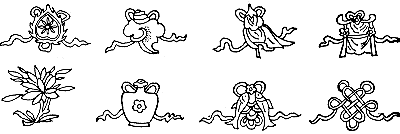
Also known as the "Eight Buddhist Treasures".
As a decorative motif, the Eight Buddhist Symbols first appeared on ceramics during the Yuan dynasty when they were introduced from the Tibetan Lamaist art, and were popular decorative elements during the Ming and Qing.
The Eight Buddhist Emblems consist of the wheel, the conch, the canopy, the umbrella, the lotus flower, the vase, the fish, and the knot. Sometimes one of these is replaced by the flaming pearl. Often, each of the emblems is combined with a lotus spray to form a design.
These emblems were impressed on Yuan Jingdezhen egg-white wares and Longqun celadons, and also on Ming sweet white wares of the Yongle reign. From the Xuande reign on, they were painted in an underglaze blue, in the five-color (wu cai) palette, in the contasting color (dou cai) technique and in yellow decoration on a green ground. During the Qianlong and Jiaqing reigns of the Qing dynasty, this design was painted in the famille rose palette and enamel decoration.
The arrangement of the emblems were random before the Yongle reign of the Ming dynasty, when the order of the symbols was established as the wheel, the conch, the canopy, the umbrella, the lotus flower, the fish, the vase, and the knot.
From the Wanli reign to the Qing dynasty the order was the following and as illustrated above, from top left:
The Chakra or, the flaming Wheel. The Wheel of the Law crushes all delusions and superstitions. A symbol of Buddha's Person, infinite changing. Also called the Wheel of Life, Wheel of Truth, Holy wheel, Wheel of 1,000 Spokes, Indestructible Wheel of the Cosmos.
The Conch Shell is a symbol of royalty, dignity and high rank, the Sacred Lungs of Buddha, spiritual authority.
The Umbrella is a symbol of spiritual authority and charity.
The Canopy or Bell implies respect, veneration, signals, martial enthusiasm. The sound disperses evil spirits.
The Lotus symbolizes faithfulness, symbol of truth, fertility and purity because its blossoms emerge pure and beautiful out of muddy waters.
The Vase symbolizes perpetual harmony, supreme intelligent triumph over birth and death. A ceremonial jar for relics.
After the Qianlong reign, on some vessels the order was not followed. Wares with this design were all produced in Jingdezhen except for some fa hua glazed wares.
See also: Hundred Antiques After the Qianlong reign, this order was not followed on some vessels. Wares with this design were all produced in Jingdezhen except for some fa hua glazed wares.
A